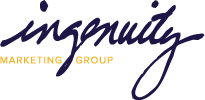
Business Development Strategy
Professional service firms have a renewed focus on proposal copywriting and design. There are a few reasons for this:
-
- Rebranding proposals with the firm’s new logo, updated colors and fonts
- Differentiating messaging and visuals in a competitive market within strict RFP or LOI limitations
- Streamlined processes and templates to deliver proposals quickly and with high impact
Ingenuity’s communications and design team has worked with several clients to improve and update their proposal copy and design. Due to client nondisclosure, we can’t discuss the clients or show examples of these projects. But we can share approaches that will help you pursue a great first impression with your proposals.
1. Rebranding Proposals
When a firm has completed a visual rebranding with a new logo, style guide and color palette, it is important to consistently represent the brand across all materials, including proposals.
Strategy
Look at the current proposal layout and the elements that are common for most proposals: cover page and cover letter, logo, headers and footers, headlines, graphic elements, bios, etc.
After identifying those common elements, concept a template that incorporates the new logo and font along with a color scheme using refreshed brand colors in headlines, charts, header and footer design and any callout elements such as client testimonials or statistics.
If your firm has branding messages, weave those into the cover letter and firm profile content. The template should be designed in a way that prevents static visual elements from being changed, but allows template users to customize the copy and edit it.
We recommend a customized Word document or PowerPoint file if InDesign or Adobe templates are not as easily edited or accessible to everyone in the firm. Using a proposal software solution can support accessibility as well as design consistency (e.g. Proposify, RFPIO, Qvidian).
Results
The new proposal template offers a consistent way for anyone creating proposals to focus their efforts on personalizing the content, with confidence that the first visual impression will be positive and professional.
2. Differentiating Proposals
When clients are limited in the way they can submit proposals, such as through government or public entities, there are still ways to differentiate your content and presentation of information. Many firms are moving toward a simplified and more visual display of information, especially when page counts and word count are restricted.
Strategy
When you have proposal restrictions, including page dimensions, try switching to a landscape layout rather than a profile layout of your pages.
Differentiation can also be achieved by creating a “key issues” section in your executive summary. This shows that you read and understood their request and unique needs.
Other tips for differentiation include showcasing client testimonials, awards, industry involvement and diversity, equity and inclusion measures. Recent studies have shown that including specific DEI measures as part of your firm profile or differentiating information, even if not asked, is recommended.
Results
A subtle change of view through a landscape layout or a box highlighting your insights about the prospect can go a long way in helping your proposal stand out from the rest. We have helped clients improve their scoring with government or public agencies by making the most important differentiators stand out with clear writing (less jargon) and strategically colored elements on the page.
3. Streamlining Proposal Templates
One of the biggest branding problems for larger firms is maintaining consistency in their proposals. Even with proposal software, someone needs to be in charge of updating template pages as things change in the firm. That person can have a full-time job when there are multiple divisions, disciplines or practices and services to track, not to mention changes in personnel.
It is also difficult to develop a strategy if you have competing voices and goals for business development. Add in knowledge of design and what’s truly possible for streamlining your template, and it is little wonder that most marketing leaders need the help of a specialist.
Strategy
Before bringing the copywriter or designer to the table, the biggest hurdle for streamlining your proposal template is to understand which elements can be universal and which elements will change with every proposal. In our experience, static elements include the cover page, the firm boilerplate (who, what, where, why) and bio layouts. Besides those elements, everything else can be customized, and every firm leader is very passionate about how their services should be portrayed. This is what makes complex proposal templates such a monumental task. But never fear! Discuss this order of planning before you even begin to discuss copy or design:
-
- Identify areas of the firm that actually require RFPs for business development
- Prioritize each area based on greatest overall business need and schedule out proposal updates accordingly
- Design the overall firm proposal shell visually without content
- Discuss with select subject matter experts the most common RFP questions and elements to include in ‘most proposals.’
- Determine with subject matter experts the elements of the template that will need to be customized every time, and make those sections easily customizable without losing design integrity.
- Develop the template outline to integrate easily with your chosen proposal software
- Roll out the templates with training and buy-in for consistent use
- Maintain an owner or owners in the firm for regular or needed updates over time
There is no shortcut to developing a proposal template for complex organizations. The pre-planning and strategy piece are vital to a successful workflow and end result.
Results
We have seen proposal projects get delayed for many reasons, ranging from leaders getting busy to those larger priorities popping up to a complete change in project ownership. Delays can be unavoidable for a project of this scope, and that’s why approaching it in planned phases or by practice or discipline can help you manage it under other inevitable pressures and deadlines.
Your result is a streamlined proposal process across the firm. Regardless of where your template(s) exist, you need ownership and maintenance for continued success as well as a rollout that gets everyone excited and comfortable using it. Handled with patience and care, you shouldn’t have to worry in the future if someone is using the most “up-to-date” proposal information for your organization. And you will put your best foot forward to win new business.
Let us know if we can help.
Quick Read: Boost your market position with partnerships and referral programs.





